November Short Fuses — Materia Critica
Each month, our arts critics — music, book, theater, dance, television, film, and visual arts — fire off a few brief reviews.
Jazz
A Soundtrack in Search of a Movie – Alan Goldsher (Gold Note Records)
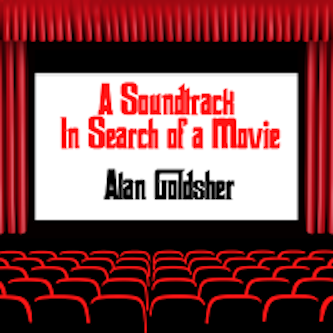 This hard-grooving collection would be a fine addition to your streaming music library (it’s not for sale that I could find). Add it to a playlist, put it on shuffle, and you’ll have 19 funky little interludes. On this album, experienced arranger and multi-instrumentalist Alan Goldsher has come up with an entertaining example of the underground genre of Library Music: in this case focusing on the incidental music for movies, TV programs, and commercials. Here, he supplies the music, and the imaginative listener provides the movie.
This hard-grooving collection would be a fine addition to your streaming music library (it’s not for sale that I could find). Add it to a playlist, put it on shuffle, and you’ll have 19 funky little interludes. On this album, experienced arranger and multi-instrumentalist Alan Goldsher has come up with an entertaining example of the underground genre of Library Music: in this case focusing on the incidental music for movies, TV programs, and commercials. Here, he supplies the music, and the imaginative listener provides the movie.
Goldsher can throw down on bass and provide the fatback on drums, humanizing the music way beyond what often passes for creativity online these days. The electronic exceptions are there for good reason, such as the subwoofer-rattling synth bass on “Bo Knows” or the hip-hop feel of “My Favorite Sport.”
There’s a ’70s-’90s retro feel to most of the disc. One track is titled “It’s the Nineties,” complete with vinyl sound effects. The track features an organ that sounds like it’s riffing on the Sanford and Son theme, and “The Written Word” recalls Barney Miller. Grooves this thick make you miss the solos, however — this would be a great practice album for providing your own.
I like the way Goldsher mixes jazz and funk across the bass and the drums. On “The Accuweather Forcast,” he plays a slick walking jazz bass line over a funk groove. “Swunk” does the opposite, with a funk bassline over a swinging jazz rhythm. “Grading” puts the two approaches together — there’s a few bars of funk, then a few bars of swing and walking bass. The tempo never budges. With a more ponderous musician, it could be a mess, but here it comes across with humor and an infectious (and affectionate) groove.
It’s a hoot to listen on the headphones as the sounds zoom and shift around to animate movie scenes in your brain. Aural popcorn, plenty of butter!
— Allen Michie
Grit & Grace – Jennifer Wharton’s Bonegasm (Sunnyside)
 Trombonist Jennifer Wharton personifies a rare presence in today’s jazz scene. She’s the leader of a band fronted by four trombonists, one of whom is her husband. Her formal background musically consists largely of playing in symphony orchestras and for Broadway shows. Count her among the very few professional jazz female trombonists who tour and teach. Wharton and her band Bonegasm could be categorized as a novelty act — but Wharton’s new recording for Sunnyside, Grit & Grace, defies that label: Wharton and her band excel at the rhythmic and harmonic freshness that propels mainstream jazz.
Trombonist Jennifer Wharton personifies a rare presence in today’s jazz scene. She’s the leader of a band fronted by four trombonists, one of whom is her husband. Her formal background musically consists largely of playing in symphony orchestras and for Broadway shows. Count her among the very few professional jazz female trombonists who tour and teach. Wharton and her band Bonegasm could be categorized as a novelty act — but Wharton’s new recording for Sunnyside, Grit & Grace, defies that label: Wharton and her band excel at the rhythmic and harmonic freshness that propels mainstream jazz.
Integral to the success of this album are the various arrangements by contemporary women composers Wharton asked to contribute to Grit & Grace. The band’s powerful rhythm section — composed of bassist Evan Gregor, percussionist Samuel Torres, and the prodigiously versatile drummer Don Peretz, along with pianist Michael Eckroth — hold their own in the face of trombonists John Fedchock, Nate Mayland, Alan Ferber, and Wharton on bass trombone. “In Our Darkest Hour” by the Australian composer Vanessa Perica, a musical portrait of US political disorder circa January 6, begins with the subdued solemnity of a New Orleans brass band marching to a cemetery to bury one of their own. The instrumental evolves from a march to a staggered dissonant dirge, resolving into a moving cry of lamentation, with percussion as much at the heart of the band’s cry as the trombones.
Not all composers contribute such gravitas. Miho Hazama’s “Norhala” transforms the character of a fantasy novel’s hero via a tune that sounds like it could have come from a trippy James Brown band. Equally wacky and smile-inducing is Nadje Noordhuis’s “Co-op’s Condiments”; Wharton sings the lyrics, a list of her fave condiments at a New Orleans eatery. That’s deliciously all, a Creole menu in song for those who crave their jazz saucy.
— Norman Weinstein
You Get More Bounce With Curtis Counce! – Curtis Counce (Contemporary) Craft LP
 Bassist Curtis Counce was ubiquitous on the West Coast scene in the mid-’50s when his most popular record, You Get More Bounce With Curtis Counce! was made in five separate sessions. Counce recorded with Chet Baker, Clifford Brown, and Lester Young, played cool with Jimmy Giuffre and hot with Stan Kenton, Bill Holman, and Max Roach. With his near contemporary, Leroy Vinnegar (who made Leroy Walks in 1957), and from the mid-’50s up until his premature death in 1963, Counce was the bassist every L.A. jazz session needed.
Bassist Curtis Counce was ubiquitous on the West Coast scene in the mid-’50s when his most popular record, You Get More Bounce With Curtis Counce! was made in five separate sessions. Counce recorded with Chet Baker, Clifford Brown, and Lester Young, played cool with Jimmy Giuffre and hot with Stan Kenton, Bill Holman, and Max Roach. With his near contemporary, Leroy Vinnegar (who made Leroy Walks in 1957), and from the mid-’50s up until his premature death in 1963, Counce was the bassist every L.A. jazz session needed.
Counce knew how to put a band together. Tenor saxophonist Harold Land had just spent a year with the magnificent Clifford Brown-Max Roach quintet, which ended with Brownie’s death in a crash. Pianist Carl Perkins was another doomed young man: he died of an overdose at 29. He’s got an invigorating bounce on “Mean to Me.” Papa Jo Jones called Frank Butler the greatest drummer in the world. He’s on Miles Davis’s Seven Steps to Heaven. It’s worth listening just to him. The trumpeter Jack Sheldon had a most interesting career. A fine bebop trumpeter, he was also an actor: he was the voice of Louie the Lightning Bug and the star of the TV show Schoolhouse Rock. Most importantly, this quintet was an exquisitely balanced group. Their fluent solos seem to flow into each other, as Perkins’s does following Sheldon’s warm-sounding musings on “Counceltation.” Land is given the spotlight on “How Deep Is the Ocean,” but when Sheldon offers some background embellishment, the effect is perfect. This is one of Land’s great performances. The sound on the Craft LP is marvelously precise, though oddly, the entire rhythm section was placed in the right channel. The warmth and skill of this quintet of youngsters still inspires.
— Michael Ullman
Destroyer – Justin Walter
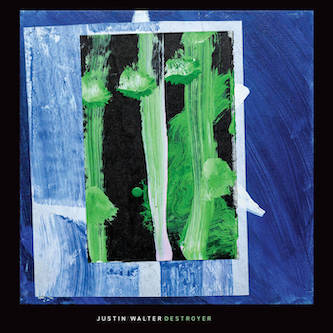 Justin Walter’s sound doesn’t just cross genre boundaries — it is ambiguous at its core. Strategically, his choice of instruments enables him to bridge jazz and electronic music. Trained as a trumpet player, he discovered the Electronic Valve Instrument. Although it looks like a trumpet, it actually controls an analog synthesizer. Walter’s latest album, Destroyer, incorporates a pump organ as well, and the recording’s unusual sonic textures stem from the way it was made. Creating electronic music without playing a keyboard or programming a DAW means that Walter’s music maintains a physical presence — his breath is still creating the notes.
Justin Walter’s sound doesn’t just cross genre boundaries — it is ambiguous at its core. Strategically, his choice of instruments enables him to bridge jazz and electronic music. Trained as a trumpet player, he discovered the Electronic Valve Instrument. Although it looks like a trumpet, it actually controls an analog synthesizer. Walter’s latest album, Destroyer, incorporates a pump organ as well, and the recording’s unusual sonic textures stem from the way it was made. Creating electronic music without playing a keyboard or programming a DAW means that Walter’s music maintains a physical presence — his breath is still creating the notes.
The only song with percussion, “For Us” depends on a rhythmic repetition that is almost danceable. “Radio Contact” integrates Walter’s trumpet with synthesizers to create a mood of lunar desolation. “Transitions” would sound peaceful — to the point of blissing listeners out — if it didn’t embrace so much white noise.
Throughout the album, Walter is concerned with harmonics and overtones, searching for spaces between standard notes. Walter also combines loops with interludes of improvisation.
Many of Walter’s reference points look back to the ’70s and early ’80s: the electronic side of Krautrock, Miles Davis’s “He Loved Him Madly” and “Yesternow,” the early days of ECM Records, Jon Hassell. Yet he brings a personal urgency to these influences. The album supplies a hint of danger as it goes through its constant changes. In words, Destroyer never lets the listener sit back and passively absorb pretty music. Its textures change from song to song, minute to minute. (On the title track, for example, an anguished distortion interrupts a quiet, steady piano pulse.) Destroyer dodges the “office playlist” trap of much recent ambient music — calm and menace are placed so close together they disconcert as they overlap. As carefully as the recording was assembled, it feels like it could collapse at any moment.
— Steve Erickson
Classical Music
Our Art in Our Time: The BCMS Commissions Volume 1/ Jalbert, Rakowski, Wheeler — (Boston Chamber Society)
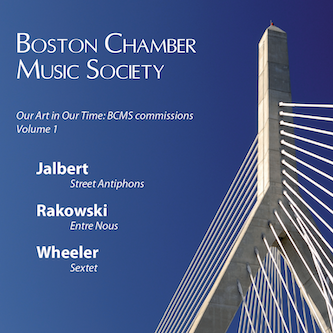 A new series of three CD recordings should bring wider attention to the Boston Chamber Music Society, an organization that began in 1982 and, since 2014, has been commissioning new works.
A new series of three CD recordings should bring wider attention to the Boston Chamber Music Society, an organization that began in 1982 and, since 2014, has been commissioning new works.
The first CD, just released, includes one work each by three notable composers with early or current roots in New England: Brandeis professor David Rakowski, Emerson College professor Scott Wheeler, and Pierre Jalbert (who grew up in Vermont and now teaches at Rice University). (Order it or preview any track here.)
The CD is unified by its performing forces: all the works use string instruments plus oboe (Rakowski), clarinet (Jalbert), or both (Wheeler). The Jalbert and Wheeler also have a part for piano, and the CD nicely puts the pianoless Rakowski between them, for contrast. The result is a 62-minute concert that uses many of the same instruments in different combinations and evokes a wide range of moods, thereby continually refreshing the ear. (You can read excerpts from the concert reviews, as well as the composers’ program notes, online.)
The Jalbert and Rakowski are each in three movements, the Wheeler in five shorter ones with intriguing titles that the composer explains in his program notes. (Wheeler’s Sextet alludes to Prokofiev’s intriguing Quintet Op. 39 and to Wheeler’s own evocative opera Naga, which I raved about here. I also greatly enjoyed a previous Jalbert work for orchestra.)
All three pieces are relatively easy to take in by ear — I never felt that I was being put to some intellectual test. Yet I also never felt that the music was dumbed-down for easy likability, either. In short, the CD left me feeling refreshed and encouraged about the future of new composition in the Boston area and beyond.
Vivid recordings, made live in the New England Conservatory’s acoustically marvelous Jordan Hall.
— Ralph P. Locke

Musicians of Old Post Road. Photo: courtesy of the artist
Musicians of the Old Post Road, Cascading Baroque Passion, on Oct 29 at First Parish Church, Sudbury, and online.
What better place to escape 21st-century news than a small and plain 18th-century Sudbury church where the Musicians of the Old Post Road launched their 35th season with a program built around the theme of water. Of the program’s six Baroque composers only one — prolific and easily recognizable Antonio Vivaldi — is well known today, even if his La Tempesta di Mare, concerto for transverse flute, strings and continuo is not.
The works of composers André Cardinal Destouches, André Campra, and Johann David Heinichen, all born between 1660 and 1683 (just before late Baroque composers J.S. Bach and Handel), have been largely forgotten. So has the music of Élisabeth Jacquet de La Guerre, one of the few women composers of the period and a child prodigy who first performed at the court of Louis XIV, represented by her French-language cantata Jonas, a setting of the Old Testament story of Jonah and the Whale.
While the program notes were a lesson in musicology, the concert itself was anything but academic: beautifully conceived and impeccably performed by the Musicians of the Old Post Road, who have played together for decades, along with violinist Jesse Irons, who has joined them since 2008, and harpsichordist Michael Sponseller, who has been with them for two seasons. The evening was engaging and entertaining, by turns energetic and lyrical. In the intimacy of the church (seven musicians in a hall seating 100), the group’s historically correct instruments — especially the transverse flute — sounded far softer and subtler than their modern counterparts.
And all this with a last-minute substitute soprano! I first heard Agnes Coakley Cox sing in a duet from the Handel & Haydn Society’s recent performance of Israel in Egypt. I was struck in Symphony Hall by the almost aching purity of her voice. It was a real thrill to hear her up close at this superb concert.
— Helen Epstein
Leonard Bernstein’s Music for String Quartet (Navona)
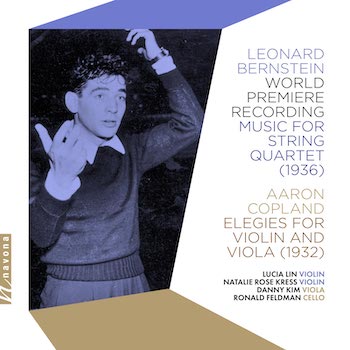
It can be fun to encounter a genius when they’re having an off day. Or, in the case of Leonard Bernstein, when he was a student.
To be sure, Bernstein’s two-movement Music for String Quartet, written in 1936 when the composer was an 18-year-old undergraduate at Harvard and only recently discovered, is, historically, an important find. Outside of a clarinet sonata and a number of short piano pieces, he wrote chamber music sparingly. The present piece, out now in its debut recording on Navona, is his only known effort in this genre.
That said, Music is very much the work of a composer finding his voice. Its two movements betray few of the melodic or harmonic qualities that make Bernstein’s mature efforts (which started emerging just a few years later, in the early 1940s) so immediately appealing and identifiable.
What it has going for it, in the first movement at least, is rhythm. That section, with its obsessive riffs and dancing, quasi-Hasidic second theme, point at least a little bit in the direction of the Scherzo from Bernstein’s Jeremiah Symphony. But this Allegro vivace is overlong and its duration weighs on the music’s effectiveness.
The searching second has somewhat less melodic and rhythmic appeal — but it does know just when to stop.
In fact, that second movement has more than a little in common, texturally, with Copland’s pensive Elegies for Violin and Viola, which fill out the short album. Essentially a study in unsettled counterpoint, it fits well tonally and spiritually with the Bernstein.
The performances — by the ad-hoc ensemble of violinists Lucia Lin and Natalie Rose Kress; violist Danny Kim; and cellist Ronald Feldman — are nothing short of inspired. The ensemble plays both works with palpable stylistic surety. They’re also beautifully recorded (in Rockport Music’s Shalin Liu Performance Center).
— Jonathan Blumhofer
Much Ado (Avie)

Fans of (mostly) early-20th-century violin music will find much to enjoy in violinist Danbi Um’s new album, Much Ado. The disc, on which Um is joined by pianist Amy Yang, offers a curious though ultimately coherent program of short pieces by Erich Wolfgang Korngold, Richard Wagner, Johannes Brahms, Jeno Hubay, Erno von Dohnányi, Joseph Achron, Leo Zeitlin, Ernest Bloch, and Fritz Kreisler.
Through it all, Um’s performances are impeccably on-point in articulation, intonation, and expressivity.
In Korngold’s Suite from Much Ado About Nothing, she brings a certain warm toughness to the outer movements, along with a bit of swagger to the second and serene lyricism to the third. Hubay’s Scenes de la Csardas No. 3 benefits from the violinist’s characterful embrace of its fervent, central part, as does Brahms’s Hungarian Dance No. 17, whose graceful trio section is surprisingly soulful.
Similar qualities mark Um’s traversal of Dohnányi’s “Gypsy Andante” and Achron’s La Romanesca, while a set of Jewish works — Zeitlin’s Eli Zion, Achron’s Hebrew Dance, and Bloch’s Avodah — are well directed and rhapsodic. Though Wagner’s short Albumblatt doesn’t leave much of an impression, Kreisler’s Viennese Rhapsodic Fantasietta closes the proceedings with a good bit of spirit.
True, Um’s reading of the last lacks some of the freedom and spontaneity found in Kreisler’s own recordings of the score. But, like everything else on this disc, her interpretation — in addition to being shapely and inviting — ably conveys the violinist’s marvelous technical facility.
Though Avie’s engineering sometimes places the piano a bit in the background, Yang’s accompaniments winningly match Um’s contributions for discretion, precision, and color.
— Jonathan Blumhofer
Rock
Brave Words — The Chills (Fire Archive)
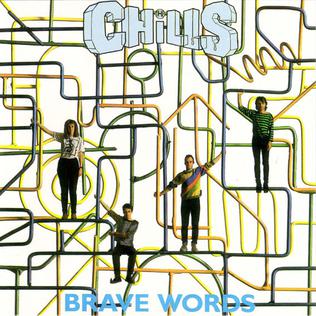 In 1987, the Chills’ Brave Words was one of the first albums by a New Zealand rock band to see international release. Long out of print, it has fallen in the cracks between the singles compilation Kaleidoscope World and the Chills’ 1990 masterpiece Submarine Bells. To be honest, it’s far more tentative than either, with muddy production that sapped the strength of singer Martin Phillipps’s songs. Fire Archive’s remastered and remixed version tries to rectify that.
In 1987, the Chills’ Brave Words was one of the first albums by a New Zealand rock band to see international release. Long out of print, it has fallen in the cracks between the singles compilation Kaleidoscope World and the Chills’ 1990 masterpiece Submarine Bells. To be honest, it’s far more tentative than either, with muddy production that sapped the strength of singer Martin Phillipps’s songs. Fire Archive’s remastered and remixed version tries to rectify that.
The Chills shared a fondness for psychedelia with many of their Flying Nun labelmates, but they were always slicker and more pop-oriented: closer to XTC or Robyn Hitchcock than the Clean’s 4-track recordings. Still, as much as they borrowed from ‘60s British rock, their Anglophilia took place at an audible remove: their jittery energy indicated that they’d lived through punk and its descendants.
Martin Phillipps’s lyrics nod to a state of uncertainty and paralysis: “I’m unhappy with me too,” he sings. On the title track, he muses about his distance from “the positive people.” “Night of Chill Blue” addresses the impossibility of dedicating a sincere love song to a person when it’s also going to be heard by the public. The album struggles to find a place of rest, a state reflected in the title “I Think I Thought of Nothing Else to Think About.”
Even with remastering, Brave Words is overly trebly, with vocals and guitar dominating. (Andrew Todd’s keyboards, which suggest a circus organist with a huge collection of ’60s garage punk, are the album’s most original element.) The bass remains barely audible, the drums only a little louder. Still, the album’s imperfections are a part of its appeal. As a collection of songs about observing the world from a distance, even in intimate relationships, the awkwardness feels natural.
— Steve Erickson
Television
Lessons in Chemistry – (Apple TV+)

A scene from Lessons in Chemistry. Photo: Apple TV+
Brie Larson shines in Apple TV+’s new series, Lessons in Chemistry, based on the novel by Bonnie Garmus. The series, set in 1950s and ’60s Los Angeles, follows Elizabeth Zott (Larson), a brilliant chemist who is stuck working as a lab tech for sexist male chemists. She begrudgingly makes them “beaker” coffee and corrects their equations while also being pressured to compete in the company’s beauty pageant (the ’50s were weird). The at-times irritating Zott becomes more likable as the series goes on, thanks to Larson’s flexibility as a performer: the character uses her chemistry skills to perfect her cooking (a key plot point for later in the series) and goes on to show a softer side after she adopts a stray dog (whom she names six-thirty because he wakes her up at six-thirty). Zott can be compliant, but she is not afraid to call out sexist practices. She has worked long enough with sharks to learn how not to become easy prey.
The other highlights of the series are its costumes and set design, which transport you back to the ’50s. Pastel-colored appliances, vibrant dresses, and enormously finny cars are all predictably on hand. What the above and beyond is how L.A. is portrayed. In the ’50s, the city wasn’t the vast metropolis it is now, and Lessons in Chemistry makes that modesty visible. Freeways have yet to become clogged mazes, though the building of one serves as a subplot. Zott’s neighbor, Harriet (Aja Naomi King, who should be given more to do), leads an organization protesting the construction of the 10 Freeway (yes, I’m from L.A. and I do put “the” in front of freeways) across their neighborhood. This intriguing subplot is based on fact, and offers an opportunity to dramatize how class and race were exploited as part of the growth of L.A.
— Sarah Osman
Books
Queer Networks: Ray Johnson’s Correspondence Art by Miriam Kienle (University of Minnesota Press, 279 pages)
 Ray Johnson was an enigmatic and reclusive artist who emerged as part of the Fluxus New York scene in the early 1960s. The movement’s ethos was to use everyday materials to challenge what is considered art. His work encompassed collage, mail art, performance, photography, repurposed found objects, and artist books.
Ray Johnson was an enigmatic and reclusive artist who emerged as part of the Fluxus New York scene in the early 1960s. The movement’s ethos was to use everyday materials to challenge what is considered art. His work encompassed collage, mail art, performance, photography, repurposed found objects, and artist books.
Johnson is best known for his foundational role in instigating the mail art movement. He meticulously (and obsessively) collaged together newspaper clippings and photos from gay physique magazines along with pictures of dead celebrities, advertisements, and personal letters to create what he called “moticos.” He mailed them to friends, art world colleagues, and sometimes strangers. He encouraged “on-sending” by asking recipients to “please send to…” or “please add to and send to…”
Miriam Kienle’s Queer Networks: Ray Johnson’s Correspondence Art analyzes this body of work through an academic lens. She argues that the artist’s mail art used camp and homoerotic imagery, as well as insertions of innuendo, to create coded queer assemblages — radical statements that were distributed through the postal service during pre-Stonewall days. In addition, his list of addressees, which including prominent LGBTQ contemporaries, can be seen as a precursor to algorithmic networks of the 21st century.
While Kienle’s thesis is astute, she focuses on only one component of this artist’s oeuvre. Johnson’s collages are extraordinary, but his performative acts, which the artist called “nothings,” were just as radical. There are those who believe that his 1995 death by suicide should be considered as his final performance. Johnson told a friend a few days prior “he was working on the biggest work he’s ever done in his life.”
Posthumously, Johnson left behind a vast archive. Over three thousand photographs found in this cache were shown in the 2022 Morgan Library & Museum exhibition Please Send to Real Life: Ray Johnson Photographs.
Kienle’s perceptive centering of queerness in Johnson’s artmaking would illuminate this work as well.
–John R. Killacky
Henry David Thoreau: Thinking Disobediently by Lawrence Buell. Oxford University Press, 152 pages.
 America’s major 19th-century Transcendentalists have often been billed as Emerson and Thoreau, the philosophical weight of the former’s call for “self-reliance” eclipsing the latter’s demand that we “live deliberately.” That order has been turned topsy-turvy, and not only because scholars have dug deeply into Thoreau’s writings left in manuscript, particularly his journals.
America’s major 19th-century Transcendentalists have often been billed as Emerson and Thoreau, the philosophical weight of the former’s call for “self-reliance” eclipsing the latter’s demand that we “live deliberately.” That order has been turned topsy-turvy, and not only because scholars have dug deeply into Thoreau’s writings left in manuscript, particularly his journals.
With the rise of the environmental movement, its importance compounded by the climate crisis, the author of Walden and the seminal essay “Civil Disobedience” has come to be seen by many as a prescient — and useful — figure. Emerson’s vision of the great outdoors in his renowned essay “Nature” is more spiritual than it was concrete. Taking in the “highly disrupted Anthropocene landscape,” Thoreau studied nature as carefully as he thought about it, concocting a lumpy mix of aesthetics, ethics, spirituality, and empiricism. Taken in its entirety, his writing proffers a rugged conjunction of political dissent and poetry, natural observation and scientific measurement, community and rebellion. As Harvard University Professor Laurence Buell writes in his valuable, if irritatingly compact, introduction to the writer, Henry David Thoreau: Thinking Disobediently, “clash though they did, poet and naturalist were also mutually reinforcing avatars.”
Buell does not stint on his subject’s contradictions and lopsided thinking, and that is a strength. Thoreau’s position as an individual rebel sits uneasily with calls for collective action. But, given the veteran scholar’s academic background as an early proponent of ecocriticism (check out 2005’s The Future of Environmental Criticism: Environmental Crisis and Literary Imagination), Buell is particularly sensitive to how Thoreau’s brand of disobedience knits together the elements in his incipiently activist vision of nature. My major complaint with the volume is that — despite Thoreau’s preference for minimalism — less is not away more. Buell’s fine 2003 book dedicated to Emerson is more extensive. It would have been valuable for him to have given the same relaxed consideration to Thoreau, particularly to his value as an intellectual exemplar today.
— Bill Marx
Design
Experience Design: A Participatory Manifesto by Abraham Burickson. (Yale University Press, 228 pages)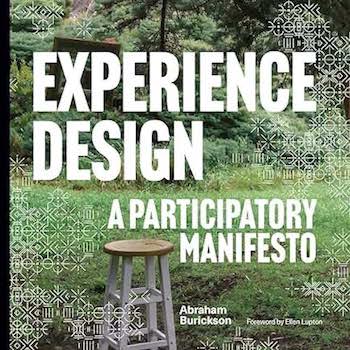
Design has always been messy to define. The approach of AI has triggered a full-out identity crisis, a blurring of the lines between the importance of design as process and design as object. One symptom of the current muddle: the popularity of jargon, particularly the use of vague, even distracting terms like user-centered design, eco-design, universal design, sustainable design, critical design, socially responsible design, transformative design, etc. Add to this linguistic and conceptual quagmire a proliferation of “how-to” books, newsletters, and even “memoirs” that attempt to integrate business school approaches with design and architecture processes.
These strategies are questionable because business school exercises are applied to the vagaries of human experience and community interactions. Rarely is the imaginative essence of design nurtured. There’s no soul, no creativity, and certainly no secret sauce; instead, we are often supplied with arrogant, idiosyncratically rendered roadmaps. Worse, these online or print “publications” often reflect an all-knowing authorial smugness. These “experts” insist they are dispensing the gospel of design. Context be damned.
Latest case in point: Yale University Press’s Experience Design: A Participatory Manifesto. The author is Abraham Burickson, a former residential architect who lacks the professional gravitas to make such dogmatic pronouncements with sometimes clever illustrative diagrams that run throughout his book.
Another example is Sam Aquillano’s Business Design School, a twice-monthly newsletter for what he calls the “creative-business-curious.” His stated mission is to help readers learn to master the profitable art of business design. What does that mean? Aquillano’s instructions are often wordy and inevitably self-promoting. His upcoming crowd-funded book is entitled Adventures in Disruption: How to Start, Survive, and Succeed as a Creative Entrepreneur.
Who are Burickson and Aquillano addressing? Who is their audience? Keep in mind that Aquillano was the founder of the Design Museum Everywhere in Boston. Unlike the Smithsonian’s Cooper-Hewitt and the Design Museum London, this “institution” has no permanent location, rarely sponsors public exhibits, and has no collection. Both authors treat design as an end in itself, depending on abracadabra rather than the magic of creativity.
— Mark Favermann
Film
Where the Devil Roams, directed by Zelda Adams, Toby Poser, and John Adams

A scene from Where the Devil Roams.
The Adams family — a married couple and their two daughters — make films together and these collaborations have slowly attracted a cult following. Their work has grown increasingly ambitious and accomplished over the years, but it still feels like outsider art. For example, they make framing and editing choices — especially when it comes to close-ups — that a professionally trained director would likely avoid. Their expansive imagination — and the sheer will needed to put it onscreen — compensates for their work’s sloppier aspects, such as the stilted dialogue and overly convoluted structure that afflicts Where the Devil Roams.
The film is set in the milieu of a backwoods carnival during the Great Depression. Performer Mr. Tipps (Sam Rodd) has made a deal with Satan: he cuts off his own fingers during his act and Eve (Zelda Adams) is given the power to sew them back onto his hand. Eve’s mother Maggie (Toby Posers) commits a string of robberies and murders as the carnival travels through the Catskills. Eve’s father, Seven (John Adams), is a doctor and blindfolds himself to avoid having to witness the mayhem. Eve enthusiastically films the homicides. Brutal violence is presented as an integral part of the family dynamic.
Fittingly for a film about the inevitability of rot, John and Zelda’s cinematography, bleached-out even at its brightest, revels in inky black-and-white. By this point, the Adams family knows how to use the austerity of tiny budgets to benefit their creativity. Most of Where the Devil Roams was shot outside, during a snowy winter: a WWI battlefield is represented by a few people in a snowy forest. Drawing on occult lore, indulging in gory mutilations, Where the Devil Roams feels like a centuries-old murder ballad sung under a frigid, unforgiving sky.
— Steve Erickson
Visual Art
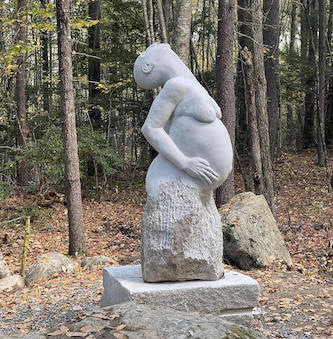
Ted Castro’s Impregnable at Andres Institute of Art. Photo Eric Doberstein
Recently, the Andres Institute of Art (AIA) International Sculpture Symposium celebrated its 23rd anniversary with new work from three resident sculptors — Ivona Biocic Mandic of Croatia, Finn Cossar of Australia, and Ted Castro from Massachusetts. During their three-week New Hampshire residency, the trio created sculptures to add to the public art mountain’s expansive exhibition (100+ pieces) of art, which mindfully meanders through 140 acres of fields, trails, and forest.
A prophetic project begun by ex-high tech entrepreneur Paul Andres (who purchased the former Big Bear Mountain Ski Resort in Brookline, New Hampshire, in 1996) in concert with master sculptor/director John Weidman, the Andres Institute of Art Sculpture Park is a unique art and nature environment open free to the public year-round. This year’s symposium included a keynote address by New Hampshire Council on the Arts director Adele Bauman, conversations between artists and the public, community dinners, artist presentations, a public art panel discussion, and closing ceremonies that feature the placement as well as the unveiling of the three new additions to the collection.
Each sculpture was very individual. Ivona Mandic’s piece is a grouping of carved abstract boulders that allowed textures, crevices, and surfaces to be “seen” and spoken to by low-sighted and blind individuals by touch and feel. Finn Cossar’s welded metalwork tower — with its granite teardrop-shape — is meant to spiritually reflect the mountain and its natural and aesthetic promise. Ted Castro’s stylized figurative granite pregnant woman speaks to birth, natural phenomenon, and potentialities.
This year’s Symposium is also the 25th anniversary of AIA. To mark the celebration, a wonderfully written and illustrated book about the life and career of award-winning sculptor John Weidman has been published. In the future, the John Weidman Artistic Achievement Medal will be presented to a distinguished former resident artist. In addition, a new wayfinding system will be integrated into the venue for ease of access and orientation.
— Mark Favermann
Tagged: "Brave Words", A Soundtrack in Search of a Movie, Aaron Keebaugh, Abraham Burickson, Alan Goldsher, Allen Michie, Andres Institute of Art, Apple TV, Avie, Bonegasm, Boston Baroque, Boston Chamber Music Society, Danbi Um, Experience Design: A Participatory Manifesto, Grit & Grace, Jennifer Wharton, John Killacky, Leonard Bernstein, Lessons in Chemistry, Mark Favermann, Miriam Kienle, Music for String Quartet, Navona Records, Ray Johnson, Steve Erickson, The Chills, Where the Devil Roams
